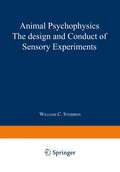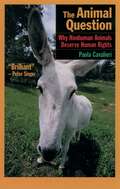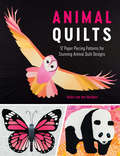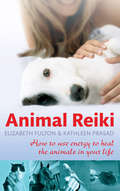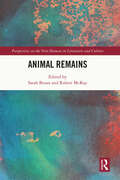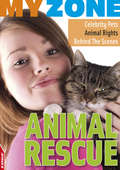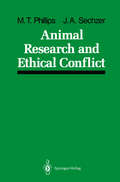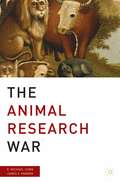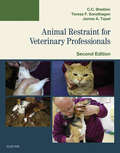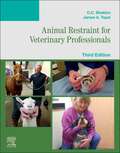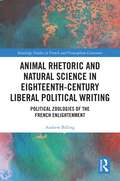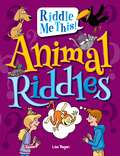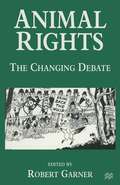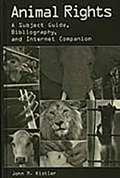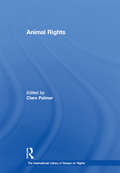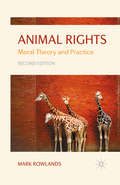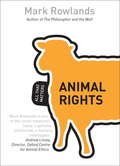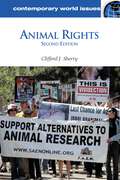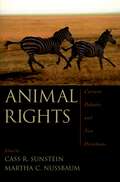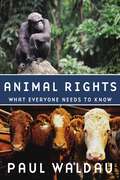- Table View
- List View
Animal Psychophysics: the design and conduct of sensory experiments
by William C. StebbinsIn May of 1969, the contributors to this book gathered at the University of Michigan in Ann Arbor for three days to talk about their work in the behavioral analysis of animal sensory function and to share their research experiences in the laboratory with particular emphasis on methodology in behavioral training, testing, and instrumentation. It was their feeling and mine as a consequence of this meeting that we had sufficient substance to justify a book which we hoped would be of interest and even of pragmatic value to any biologic or biomedical scientist whose work deals with sensory function. Clearly, there is no aspect of an organism's behavior that is not to some extent con trolled by environmental stimuli. In recent years, due in large part to technical advances in microscopy and histology and in electrophysiology, there have been several extremely informative published proceedings from conferences and symposia concerned with some of the early and very basic stages in the reception of environmental energy by the sense organs and its processing by the nervous system. Transduction at the receptor and stimulus coding by the nervous system, cell membrane changes, and the basic structure of the receptor and related tissue as seen through the electron and phase contrast microscope have received major attention, and exciting new discoveries in sen sory function and structure have been reported. Ultimately, such discoveries must be related to an intact behaving organism.
The Animal Question: Why Nonhuman Animals Deserve Human Rights
by Paola CavalieriHow much do animals matter--morally? Can we keep considering them as second class beings, to be used merely for our benefit? Or, should we offer them some form of moral egalitarianism? Inserting itself into the passionate debate over animal rights, this fascinating, provocative work by renowned scholar Paola Cavalieri advances a radical proposal: that we extend basic human rights to the nonhuman animals we currently treat as "things." Cavalieri first goes back in time, tracing the roots of the debate from the 1970s, then explores not only the ethical but also the scientific viewpoints, examining the debate's precedents in mainstream Western philosophy. She considers the main proposals of reform that recently have been advanced within the framework of today's prevailing ethical perspectives. Are these proposals satisfying? Cavalieri says no, claiming that it is necessary to go beyond the traditional opposition between utilitarianism and Kantianism and focus on the question of fundamental moral protection. In the case of human beings, such protection is granted within the widely shared moral doctrine of universal human rights' theory. Cavalieri argues that if we examine closely this theory, we will discover that its very logic extends to nonhuman animals as beings who are owed basic moral and legal rights and that, as a result, human rights are not human after all.
Animal Quilts: 12 Paper Piecing Patterns for Stunning Animal Quilt Designs
by Juliet van der HeijdenCreate incredible quilts for your home with this collection of foundation paper-pieced quilt patterns featuring 12 different animals. Learn how to create realistic representations of your favourite animals and birds in stunning paper-pieced quilt blocks. This unique collection of 12 contemporary quilt patterns includes a tiger, butterfly, swan, owl, peacock and polar bear as well as many more. There are instructions to show how to resize the quilt blocks if you want to make them larger, as well as instructions for how to add borders to increase the size of the overall quilt. Author and foundation paper piecing expert, Juliet van der Heijden, explains how your fabric choice can really alter the overall effect of the quilt patterns to create very different results, and she encourages you to have fun and adapt the quilt patterns through your own choice of fabrics. There are step-by-step instructions showing Juliet's foundation paper-piecing techniques and all the pattern pieces are available via a PDF download.
Animal Reiki: How to use energy to heal the animals in your life
by Elizabeth Fulton Kathleen PrasadReiki is particularly effective in healing animals but there is very little specific information currently available. Whether you are a newcomer to the field of energy medicine, an experienced practitioner or an animal lover committed to learning everything you can about your companion's health, Animal Reiki will open your eyes to a new level of healing and wellbeing. From dogs and cats to horses and birds, this book is everything you need to understand and appreciate the power of Reiki to heal and deepen the bond with the animals in your life.
Animal Remains (Perspectives on the Non-Human in Literature and Culture)
by Sarah Bezan Robert McKayThe dream of humanism is to cleanly discard of humanity’s animal remains along with its ecological embeddings, evolutionary heritages and futures, ontogenies and phylogenies, sexualities and sensualities, vulnerabilities and mortalities. But, as the contributors to this volume demonstrate, animal remains are everywhere and so animals remain everywhere. Animal remains are food, medicine, and clothing; extractive resources and traces of animals’ lifeworlds and ecologies; they are sites of political conflict and ontological fear, fetishized visual signs and objects of trade, veneration and memory; they are biotechnological innovations, and spill-over viruses. To make sense of the material afterlives of animals, this book draws together multispecies perspectives from literary criticism and theory, cultural studies, anthropology and ethnography, photographic and film history, and contemporary art practice to offer the first synoptic account of animal remains. Interpreting them in all their ubiquity, diversity and persistence, Animal Remains reveals posthuman relations between human and nonhuman communities of the living and the dead, on timescales of decades, centuries, and millennia.
Animal Remains (Perspectives on the Non-Human in Literature and Culture)
by Sarah Bezan Robert McKayThe dream of humanism is to cleanly discard of humanity’s animal remains along with its ecological embeddings, evolutionary heritages and futures, ontogenies and phylogenies, sexualities and sensualities, vulnerabilities and mortalities. But, as the contributors to this volume demonstrate, animal remains are everywhere and so animals remain everywhere. Animal remains are food, medicine, and clothing; extractive resources and traces of animals’ lifeworlds and ecologies; they are sites of political conflict and ontological fear, fetishized visual signs and objects of trade, veneration and memory; they are biotechnological innovations, and spill-over viruses. To make sense of the material afterlives of animals, this book draws together multispecies perspectives from literary criticism and theory, cultural studies, anthropology and ethnography, photographic and film history, and contemporary art practice to offer the first synoptic account of animal remains. Interpreting them in all their ubiquity, diversity and persistence, Animal Remains reveals posthuman relations between human and nonhuman communities of the living and the dead, on timescales of decades, centuries, and millennia.
Animal Rescue (EDGE: My Zone #2)
by Anita GaneriMY ZONE is the hottest place to come for news, gossip, facts and stories from scenes that matter to you. Top picks from inside Animal Rescue: - Cruelty-free shopping- At a rescue centre- Animal experiments- Puppy farms- Star pets- Is having a pet OK?- Top ten pets- Star pets- Working with animals- Cheetah rescue- Are zoos cruel or cool?- Animal quizzes- My rescue pet
Animal Research and Ethical Conflict: An Analysis of the Scientific Literature: 1966–1986
by Mary T. Phillips Jeri A. SechzerThis volume grew out of a project to conduct a survey of the scientific literature of the United States for items addressing the e. thical and humane issues of animal experimentation. The original purpose of the survey was to provide packground information for the development of a set of guide lines for the use of animals in research then in preparation by The New York Academy of Sciences' Ad Hoc Committee on Animal Research. ! We soon realized, however, that the survey constituted a valuable resource in its own right. In this book we present the results of the literature survey along with relevant information about its legislative and historical con text. We hope that this material will be helpful to biomedical researchers grappling with animal welfare problems as well as to social scientists interested in tracing the evolution of the 20th-century phase of the animal research controversy. The time span covered by the survey was selected to match the 20-year period between the passage of the first federal Animal Welfare Act in 1966 and the most recent legislation regulating animal research, which took effect during 1986. Our analysis examines this transitional period through the pages of the scientific literature. During these 2 decades, animal re search in the United States was transformed. Activist animal protection organizations catapulted troublesome ethical questions to national prom inence, throwing the scientific community2 into turmoil.
The Animal Research War
by P. Conn J. ParkerThis thoughtful and surprising book analyzes the effect of animal extremism on the world's scientists, their institutions, and professional societies. The Animal Research War traces the evolution of the animal rights movement, profiles its leadership, and reveals the truth behind university animal research.
Animal Restraint for Veterinary Professionals - E-Book
by C. C. Sheldon Teresa F. Sonsthagen James TopelLearn effective animal handling and restraint techniques! Animal Restraint for Veterinary Professionals, 2nd Edition describes each procedure with two to eight photos showing the exact steps needed to achieve safe restraint. A chapter is devoted to each domestic animal species, including cats, dogs, cattle, horses, sheep, goats, pigs, rabbits, rodents, ferrets, and birds. New to this edition are updated photographs showing the latest and greatest restraint procedures for all types of animals. Written by expert veterinary technician educators C.C. Sheldon, Teresa Sonsthagen, and James Topel, this practical guide also includes a chapter on knot tying!Step-by-step guidelines make it easy to understand safe, proper restraint procedures.Over 500 full-color photographs illustrate restraint procedures.A clear, non-technical writing style along with descriptive photographs simplifies animal restraint concepts.Comprehensive coverage in each chapter includes normal and abnormal behavior characteristics, precautions, special handling, restraint devices, and descriptions of medical procedures — such as venipuncture — for which special restraint procedures are necessary.Restraint Principles chapter summarizes the considerations for restraint, animal safety, circumstances for restraint, the effect of restraint on animals, and complications. Knot Tying chapter presents basic types of knots that may be used to safely restrain larger animals. UPDATED chapters include behavioral observations describing what to look for in the animal being restrained.NEW full-color photographs accompany new restraint procedures for various species.NEW! Alternative restraint techniques are added, accompanied by step-by-step photos.
Animal Restraint for Veterinary Professionals - E-Book: Animal Restraint for Veterinary Professionals - E-Book
by C. C. Sheldon James TopelMaster proven techniques for the handling and restraint of common animals! Providing clear guidelines to each procedure, Animal Restraint for Veterinary Professionals, 3rd Edition includes photos showing the exact steps needed to achieve safe restraint of animals seen in the veterinary clinic and visited on farm calls. Separate chapters are devoted to each domestic animal species, including cats, dogs, cattle, horses, sheep, goats, pigs, rabbits, rodents, ferrets, and birds. This edition adds descriptions of new restraint techniques for cats, dogs, and other species. Written by expert veterinary technician instructors C.C. Sheldon, and James A. Topel, this practical guide also includes a chapter on knot tying! Step-by-step guidelines make it easy to understand safe, commonly used restraint procedures, and include alternative restraint techniques for several different species. More than 500 full-color images and a clear, non-technical writing style depict and simplify animal restraint concepts. Comprehensive coverage includes normal and abnormal animal behavior characteristics, precautions, special handling, restraint devices, and descriptions of special restraint techniques for medical procedures such as venipuncture. Restraint Principles chapter summarizes the considerations for proper restraint, animal safety, circumstances for restraint, the effect of restraint on animals, and complications. Knot Tying chapter presents basic types of knots that may be used to safely restrain larger animals. NEW! Additional restraint techniques are included for several species. NEW! Restraint of Cats chapter is updated to include guidelines and photos for the removal of cats from a carrier, examination in a carrier, and examination in a towel on the handler's lap. NEW! Restraint of Dogs chapter is updated to include canine head control using a towel, along with safe techniques for administering intramuscular injections to aggressive dogs including the use of a door as a squeeze area and hip catch. NEW! Learning objectives, chapter outlines, and key terms are added to the beginning of each chapter.
Animal Rhetoric and Natural Science in Eighteenth-Century Liberal Political Writing: Political Zoologies of the French Enlightenment (Routledge Studies in French and Francophone Literature)
by Andrew BillingOur tendency to read French Enlightenment political writing from a narrow disciplinary perspective has obscured the hybrid character of political philosophy, rhetoric, and natural science in the period. As Michèle Duchet and others have shown, French Enlightenment thinkers developed a philosophical anthropology to support new political norms and models. This book explores how five important eighteenth-century French political authors—Rousseau, Diderot, La Mettrie, Quesnay, and Rétif de La Bretonne—also constructed a "political zoology" in their philosophical and literary writings informed by animal references drawn from Enlightenment natural history, science, and physiology. Drawing on theoretical work by Derrida, Latour, de Fontenay, and others, it shows how these five authors signed on to the old rhetorical tradition of animal comparisons in political philosophy, which they renewed via the findings and speculations of contemporary science. Engaging with recent scholarship on Enlightenment political thought, it also explores the links between their political zoologies and their family resemblance as "liberal" political thinkers.
Animal Rhetoric and Natural Science in Eighteenth-Century Liberal Political Writing: Political Zoologies of the French Enlightenment (Routledge Studies in French and Francophone Literature)
by Andrew BillingOur tendency to read French Enlightenment political writing from a narrow disciplinary perspective has obscured the hybrid character of political philosophy, rhetoric, and natural science in the period. As Michèle Duchet and others have shown, French Enlightenment thinkers developed a philosophical anthropology to support new political norms and models. This book explores how five important eighteenth-century French political authors—Rousseau, Diderot, La Mettrie, Quesnay, and Rétif de La Bretonne—also constructed a "political zoology" in their philosophical and literary writings informed by animal references drawn from Enlightenment natural history, science, and physiology. Drawing on theoretical work by Derrida, Latour, de Fontenay, and others, it shows how these five authors signed on to the old rhetorical tradition of animal comparisons in political philosophy, which they renewed via the findings and speculations of contemporary science. Engaging with recent scholarship on Enlightenment political thought, it also explores the links between their political zoologies and their family resemblance as "liberal" political thinkers.
Animal Riddles (Riddle Me This!)
by Lisa ReganWhat single letter can you swap to make a cold bear hot? Journey through the animal kingdom with this mammoth collection of over 60 riddles. These include: • Traditional riddles • New riddles • Logic puzzles • Tongue-twisters • Silly puns • And more! Featuring hilarious cartoon illustrations of all your favourite furry friends, this full-colour book will delight all readers aged 7+. ABOUT THE SERIES: Riddle Me This is packed full of clever riddles and hilarious cartoon illustrations, designed to appeal to children. Each title follows a popular theme, from animals to school to underwater riddles, so readers age 7+ can puzzle, ponder and stretch their minds.
Animal Rights: The Changing Debate
by Robert GarnerThis book, written by leading academics and activists, examines the development of animal rights over the past two decades and asks where the issue goes from here. The contributions cover animal rights philosophy, strategies of the animal rights movement, the treatment of animals in specific contexts and the political arena within which animal advocates must operate. The unifying theme is provided by an emerging debate about the future direction of the animal protection movement, and, in particular, about the utility of using rights language as a means of achieving further progress.
Animal Rights: A Subject Guide, Bibliography, and Internet Companion (Non-ser.)
by John M. KistlerIntroductions to each chapter explain the issues, as well as the arguments that surround them, and a general introduction to the volume thoroughly explains how to use the book. Each entry contains the following information: author, title, edition, series title, location of publisher, name of publisher, number of pages, year of publication, and International Standard Book Number. Annotations include the most important information available to help the researcher, including web sites that contain not only the full text of the book when available, but also excerpts and articles or interviews by the author; short quotations from the books; and short descriptions and summaries of the books. All the information provided allows students to locate exactly what they need, while encouraging them to explore other issues and differing viewpoints.
Animal Rights (The International Library of Essays on Rights)
by Clare PalmerDo animals have moral rights? If so, which ones? How does this affect our thinking about agriculture and experimentation? If animals have moral rights, should they be protected by law? These are some of the questions addressed in this collection, which contains more than 30 papers spanning nearly 40 years of debates about animal rights. It includes work by leading advocates of animal rights both in philosophy and law, as well as contributions by those resolutely opposed to the very idea of animal rights. A substantial Introduction surveys key arguments in the area and puts the papers in context.
Animal Rights (The International Library of Essays on Rights)
by Clare PalmerDo animals have moral rights? If so, which ones? How does this affect our thinking about agriculture and experimentation? If animals have moral rights, should they be protected by law? These are some of the questions addressed in this collection, which contains more than 30 papers spanning nearly 40 years of debates about animal rights. It includes work by leading advocates of animal rights both in philosophy and law, as well as contributions by those resolutely opposed to the very idea of animal rights. A substantial Introduction surveys key arguments in the area and puts the papers in context.
Animal Rights: Moral Theory and Practice
by Mark RowlandsIn this 2nd edition the author has substantially revised his book throughout, updating the moral arguments and adding a chapter on animal minds. Importantly, rather than being a polemic on animal rights, this book is also a considered and imaginative evaluation of moral theory as explored through the issue of animal rights.
Animal Rights: All That Matters Ebook (All That Matters)
by Mark RowlandsAnimal Rights is a big deal. From animal testing to vegetarianism, and hunting to preservation of fish stocks, it's a topic that's always in the news. Mark Rowlands, author of The Philosopher and the Wolf, is the world's best known philosopher of animal rights. In this, the first introduction he has written to the topic, he starts by asking whether there is anything about humans that makes us psychologically or physiologically distinctive - so that there might be a moral justification for treating animals in a different way to how we treat humans. From this foundation, he goes on to explore specific issues of eating animals, experimentation, pets, hunting, zoos, predation and engineering animals. He ends with a challenging argument of how an improved understanding of animal ethics can and should affect readers' choices.
Animal Rights: A Reference Handbook (Contemporary World Issues)
by Clifford J. SherryThis revised edition helps readers understand and develop their own opinions on the fundamental issues, enduring controversies, and critical developments associated with animal rights.First published in 1994, Animal Rights: A Reference Handbook was widely acclaimed for its objective look at the ways in which humans treat animals. Extensively revised and updated, this new edition explores the basis for current perspectives on animal rights by addressing the relationship between humans and animals from scientific, philosophical, legal, and religious points of view.Animal Rights: A Reference Handbook, Second Edition maintains the balance and accessibility of the first edition, letting readers decide the bounds of human responsibility toward animals. It surveys a wide range of controversies surrounding the use of animals in such fields as the food industry, medical research, and the realm of entertainment, as well as the tremendous surge in scientific discoveries and technological advances that have led to new conversations on animal rights in the 21st century.
Animal Rights: Current Debates and New Directions
by Cass R. Sunstein Martha C. NussbaumCass Sunstein and Martha Nussbaum bring together an all-star cast of contributors to explore the legal and political issues that underlie the campaign for animal rights and the opposition to it. Addressing ethical questions about ownership, protection against unjustified suffering, and the ability of animals to make their own choices free from human control, the authors offer numerous different perspectives on animal rights and animal welfare. They show that whatever one's ultimate conclusions, the relationship between human beings and nonhuman animals is being fundamentally rethought. This book offers a state-of-the-art treatment of that rethinking.
Animal Rights: Current Debates and New Directions
by Cass R. Sunstein Martha C. NussbaumCass Sunstein and Martha Nussbaum bring together an all-star cast of contributors to explore the legal and political issues that underlie the campaign for animal rights and the opposition to it. Addressing ethical questions about ownership, protection against unjustified suffering, and the ability of animals to make their own choices free from human control, the authors offer numerous different perspectives on animal rights and animal welfare. They show that whatever one's ultimate conclusions, the relationship between human beings and nonhuman animals is being fundamentally rethought. This book offers a state-of-the-art treatment of that rethinking.
Animal Rights: What Everyone Needs to Know® (What Everyone Needs To Know®)
by Paul WaldauIn this compelling volume in the What Everyone Needs to Know® series, Paul Waldau expertly navigates the many heated debates surrounding the complex and controversial animal rights movement. Organized around a series of probing questions, this timely resource offers the most complete, even-handed survey of the animal rights movement available. The book covers the full spectrum of issues, beginning with a clear, highly instructive definition of animal rights. Waldau looks at the different concerns surrounding companion animals, wild animals, research animals, work animals, and animals used for food, provides a no-nonsense assessment of the treatment of animals, and addresses the philosophical and legal arguments that form the basis of animal rights. Along the way, readers will gain insight into the history of animal protection-as well as the political and social realities facing animals today-and become familiar with a range of hot-button topics, from animal cognition and autonomy, to attempts to balance animal cruelty versus utility. Chronicled here are many key figures and organizations responsible for moving the animal rights movement forward, as well as legislation and public policy that have been carried out around the world in the name of animal rights and animal protection. The final chapter of this indispensable volume looks ahead to the future of animal rights, and delivers an animal protection mandate for citizens, scientists, governments, and other stakeholders. With its multidisciplinary, non-ideological focus and all-inclusive coverage, Animal Rights represents the definitive survey of the animal rights movement-one that will engage every reader and student of animal rights, animal law, and environmental ethics. What Everyone Needs to Know® is a registered trademark of Oxford University Press.
